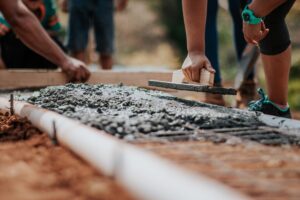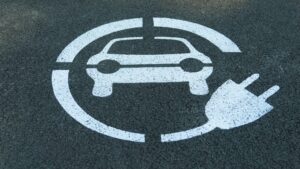Stormwater is water that originates from precipitation (storm), including rain and meltwater from hail and snow. In the buildings, it’s a system of collecting stormwater from roofs and sites and preventing all or a large portion of it from entering the municipal stormwater system. Stormwater capture can be broken into two approaches: detention systems that manage the stormwater runoff from building sites, and retention systems that utilize the stormwater for other purposes, such as irrigation, toilet flushing, and cooling towers.
CALGreen Code Section 5.106.1: Stormwater pollution prevention for projects that disturb less than one acre of land.
Newly constructed projects and additions which disturb less than one acre of land and are not part of a larger common plan of development or sale shall prevent the pollution of stormwater runoff from the construction activities through one or more of the following measures:
CALGreen Code Section 5.106.1.1: Local ordinance.
Comply with a lawfully enacted stormwater management and/or erosion control ordinance.
CALGreen Code Section 5.106.1.2: Best management practices (BMP’s).
Prevent the loss of soil through wind or water erosion by implementing an effective combination of erosion and sediment control and good housekeeping BMP’s.
1. Soil loss BMP that should be considered for implementation as appropriate for each project include, but are not limited to, the following:
a. Scheduling construction activity during dry weather, when possible.
b. Preservation of natural features, vegetation, soil, and buffers around surface waters.
c. Drainage swales or lined ditches to control stormwater flow.
d. Mulching or hydroseeding to stabilize disturbed soils.
e. Erosion control to protect slopes.
f. Protection of storm drain inlets (gravel bags or catch basin inserts).
g. Perimeter sediment control (perimeter silt fence, fiber rolls).
h. Sediment trap or sediment basin to retain sediment on site.
i. Stabilized construction exits.
j. Wind erosion control.
k. Other soil loss BMP’s acceptable to the enforcing agency
2. Good housekeeping BMP’s to manage construction equipment, materials, non-stormwater discharges, and wastes that should be considered for implementation as appropriate for each project include, but are not limited to, the following:
a. Dewatering activities.
b. Material handling and waste management.
c. Building materials stockpile management.
d. Management of washout areas (concrete, paints, stucco, etc.).
e. Control of vehicle/equipment fueling to contractor’s staging area.
f. Vehicle and equipment cleaning performed off site.
g. Spill prevention and control.
h. Other housekeeping BMP’s acceptable to the enforcing agency
Intent:
The intent of this requirement is to prevent the loss of soil through wind or water erosion by implementing effective combination of erosion and sediment control and good housekeeping Best Management Practices (BMPs).
Compliance Method:
Indicate on the construction documents methods used to comply with the preceding requirements. One of the following must be indicated in the construction documents:
• How a local stormwater management ordinance is being met;
• The BMP that will be employed, specific to the site and season of construction;
• Stormwater Pollution Management Plan requirements listed;
• Delegation of stormwater control measures to the contractor for his or her separate submittal to the enforcing agency prior to commencement of excavation and grading; or
• A descriptive method deemed acceptable to the enforcing agency
Contractor: No grading should be done until site and season-specific soil loss and housekeeping stormwater BMP have been approved by the enforcing agency. The contractor should employ the design BMP and any other control measure, as the need arises. The contractor should also conduct site inspections before, during and after each extended storm event in order to identify conditions that may contribute to erosion and sediment problems or any other pollutant discharges. If additional control measures are needed, the contractor should implement them immediately.
Enforcement:
Plan intake: The plan reviewer should make sure that the stormwater pollution prevention BMP meets the regulations or local requirements. The BMP may be included with the construction documents (plans and/or specifications) or submitted separately.
On-site enforcement: The inspector should check the erosion and sediment controls for conformance with the BMP during the normal inspection process. A separate inspection may be deemed appropriate by the enforcing agency. Additional site inspections may be required during extended storm events to verify mitigation measures.
CALGreen Code Section 5.106.2: Stormwater pollution prevention for projects that disturb one or more acres of land.
Comply with all lawfully enacted stormwater discharge regulations for projects that (1) disturb one acre or more of land, or (2) disturb less than one acre of land but are part of a larger common plan of development or sale.
Note: Projects that (1) disturb one acre or more of land, or (2) disturb less than one acre of land but are part of a larger common plan of development or sale must comply with the post-construction requirements detailed in the applicable National Pollutant Discharge Elimination System (NPDES) General Permit for Stormwater Discharges Associated with Construction and Land Disturbance Activities issued by the State Water Resources Control Board or the Lahontan Regional Water Quality Control Board (for projects in the Lake Tahoe Hydrologic Unit).
The NPDES permits require post-construction runoff (post-project hydrology) to match the pre-construction runoff (pre-project hydrology) with the installation of post-construction stormwater management measures. The NPDES permits emphasize runoff reduction through on-site stormwater use, interception, evapotranspiration, and infiltration through non-structural controls, such as Low Impact Development LID practices, and conservation design measures.
Stormwater volume that cannot be addressed using non-structural practices is required to be captured in structural practices and be approved by the enforcing agency.
Refer to the current applicable permits on the State Water Resources Control Board website at: www.waterboards.ca.gov/constructionstormwater. Consideration to the stormwater runoff management measures should be given during the initial design process for appropriate integration into site development.
Intent:
The intent of this code section reference is to alert the code user of two specific state permitting requirements for projects that disturb one or more acres of land, and in some cases even projects that disturb less than one acre but are part of a larger common plan of development or sale. These permitting requirements are administered by the State Water Resources Control Board (SWRCB) and are not a requirement in the CALGreen Code to be administered by the local enforcing agencies.
Compliance Method:
If a project consists of a site that meets the criteria listed in Section 5.106.2, obtain the appropriate NPDES permit. Refer to the current applicable permit requirements on the State Water Resources Control Board website at: www.waterboards.ca.gov/constructionstormwater
(Excerpted from ‘Guide to the 2019 California Green Building Standards Code Nonresidential’ – Chapter 5)



